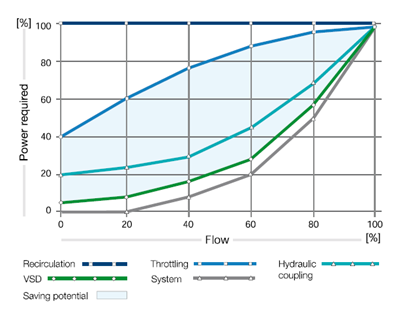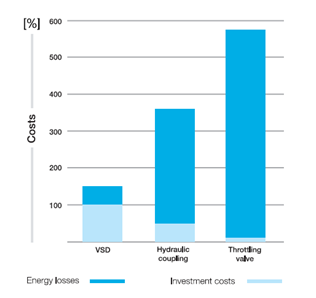Cases of VFD
VFDs Applied to Pumps in the Cement Factory
Due to transport cooling water/ wastewater and mortar, there are some pumps in the cement factories. Pumps are characterized by high-reliability requirements and fairly high dynamics during load changes. They normally make the biggest contribution to a plant’s own energy consumption.
With today's VFD technology those pumps can be controlled with the best possible efficiency without compromising reliability. Furthermore, mechanical maintenance costs can be reduced by controlling the water flow with VFDs instead of throttling valves or hydraulic couplings.

Fig.1 Power consumption for various pump control methods

Fig.2 Comparison of investment costs and energy losses of different control methods
The advantage of Kinfoss VFDs driving:
1.Significant energy savings
Normally in the cement plant, they use pumps for loads. But almost all of the pumps were directly driven by grid power. The speed of running pump cannot be changed. Actually, these pumps do not always run at rated speed. After using VFD pumps run at Optimum operating condition so there is significant energy saving. From site running date, some pumps energy saving ratio can reach 30%.
2.PID control
VFDs build in PID function which can keep the pressure of water or juice stable. It is better for piping and can reduce the loss of shutdown maintenance and save plenty of maintenance costs. Increase lifetime of pumps.
3.More protection for pumps
There is plenty of motor protection, such as overcurrent/overvoltage/overheat and etc. It can protect the motor better.
4.Soft start
A direct-on-line started electric motor can cause starting currents of up to six times the nominal current. This will cause a voltage drop that is likely to disturb the process, especially if the supply network is weak.
Starting with VFDs are Controlled and smooth start-up
